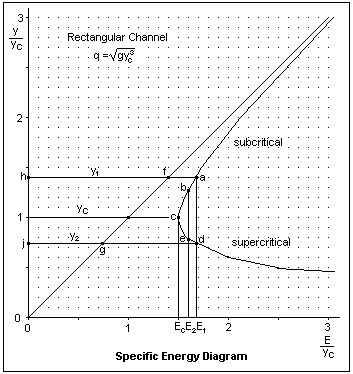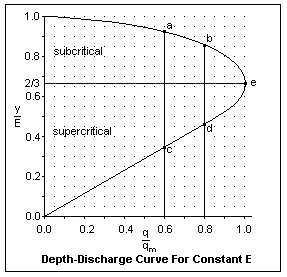Specific energy
Specific energy at a particular section is defined as
The total head with respect to the bed of the channel.
Or
The total head at a cross section by taking the datum passing through the bed of section at that section.

Or

Critical depth
Critical depth may be defined as
The depth corresponding to the minimum value of Specific energy, provided that the discharge remaining constant is known as critical depth.

Alternate depths
As we can see the graphical relation between specific energy and depth. For any E value, q remaining constant, there are two possible “y” values, say y1 and y2. These two depths are called as alternate depths.
However for minimum specific energy Ec, there is only one corresponding depth “yc” which is called as critical depth. The velocity at this point is known as critical velocity.
Upper part of the curve
- If the value of “E” increases on the upper part of the curve, then “y” increases.
- For upper part, “y” is greater than “yc”.
- For upper part of the curve, velocity is less than critical velocity.
- The flow in this portion is termed as sub-critical flow.
- The channel is called as deep channel for sub-critical flow.
Lower part of the curve
- If the value of “E” increases, we can see that the value of “y” decreases in lower part of the curve.
- For lower part of the curve, “y” is less than “yc”.
- For lower part of the curve, velocity is greater than critical velocity.
- For lower part of the curve, the flow is termed as super critical flow.
- The channel is called as shallow channel for super critical flow.
Critical depth (Alternate approach)
There is another way of defining the critical depth as well, which is :
The depth corresponding to maximum discharge, E remaining constant.

At point e, in the above figure, the depth is critical depth.
how do specific energy changes along the channel and get minimum at the critical depth?
Isn’t that the specific energy should remain constant at any position in the channel, if we ignore head loss?